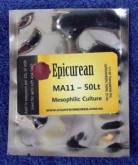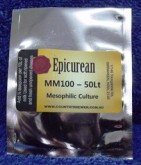 Loading... Please wait...
Loading... Please wait...- Home
- Cheese Making
- Yoghurt and Kefir
- Kefir Culture
Kefir Culture
Product Description
Kefir is a cultured, creamy dairy product with amazing health attributes.
Kefir’s tart and refreshing flavor is similar to a drinking-style yoghurt. It contains beneficial yeast as well as friendly probiotic bacteria found in some yogurts. The bacteria and yeast in kefir combine symbiotically to give superior health benefits when consumed regularly. It is loaded with valuable vitamins and minerals and contains easily digestible complete proteins.
For the lactose intolerant, kefir’s abundance of beneficial yeast and bacteria provide lactase, an enzyme which consumes most of the lactose left after the culturing process.
Directions:
1. Heat 1 litre of pasteurised milk to between 25-30°C.
2. Add ½ tspn of Culture and stir well.
3. Keep mixture at 25-30°C for 10 – 16 hrs before refrigerating.
4. Kefir will keep for up to 12 days in the fridge.
Makes 10 x 1 litre batches
Contains the following yeast culture and bacterial strains:
Candida colliculosa - single strain yeast that imparts slightly yeasty/fruity flavours.
Lactococcus lactis subsp. cremoris/lactis
Leuconostoc spp.
Lactococcus lactis /biovar. diacetylactis
Streptococcus thermophilus


Product Reviews
-
Kefir

Posted by Colin on 25th Aug 2024
I start with 500ml full cream UHT milk and 500ml fresh full cream milk + a few drops of calcium chloride,heat to 30 degrees C, I put the cultured mix in a foam box with a home brew heat pad,cold climate here,it stays at around 27 degrees, the 16 hours recommended isn't enough I reckon,I check it after 16 hours,if you go too long it separates too much.
-
Easy, quick and tastes good

Posted by Suzanne on 23rd Mar 2023
Complete newbie and my first 3 batches have worked (experimenting with different approaches).
Batch 1 (anaerobic): Added 1/2 t of culture and ~750ml supermarket milk to a 1 litre bottle. Screwed lid on bottle. Left on bench top (Brisbane, ~25oC-30oC). Inverted ~2 times over 24 hours. Then mix was ready to consume (and I refrigerated it). Was a bit sour and fizzy for my initial liking but I got used to it.
Batch 2 (aerobic): Added 1/2 t of culture and ~750ml supermarket milk to rectangular Tupperware container (no cover) *but* forgot to let milk rise to room temperature. Left on counter top. ~20 hours later thought nothing had happened and refrigerated it. Next morning it had turned into lovely, creamy, mild 'yoghurt.'
Batch 3 (aerobic): As per batch 2 but I remembered to let the milk rise to room temperature (25oC). After 24-36 hours on the counter top it tastes like...kefir. It's a bit lumpy and separated but tastes nice, and is now in the fridge.
Batch 4: haven't made it yet but may start anaerobic (which seemed to ferment quicker) and then change to aerobic.
Loving the learning process, and consuming the results.
-
Lovely Product

Posted by Bribie G on 21st Aug 2014
I ignore the instructions, just remove a cup of milk out of a 2L bottle of superior milk such as Manning Valley Farmers (kefir can swell so take some milk out). Then add a tsp of culture and leave in a warm place for a couple of days, shaking well when you think of it. It's fermented and creamy in about 3 days then gets slightly more tart and fizzy over subsequent days. No need to keep in fridge.
-
yummy

Posted by marcin on 19th Apr 2013
Awesome taste, makes a great healthy breakfast drink. In colder months, we use one of the supermarket youghurt maker thermoses and leave overnight for a constant supply of yummy goodness!














